Heritage
The solar corona can be observed from space out to tens of solar radii beyond the disk limb. Visible-light observations reveal the shape and evolution of coronal structures, modeled by the solar magnetic field. In addition, the electron density of the structures can be derived by selecting the polarized signal of the coronal light. Gigantic and violent coronal transients, whose frequency is related to the level of solar activity, are sporadically observed.
The introduction of new spectroscopic techniques, applicable to the ultraviolet band, has allowed a step forward, making it possible to observe the origin and acceleration of the solar wind in corona. The idea to use Doppler-dimming techniques to measure the continuous coronal expansion of the hot corona, put forward by Giancarlo Noci of the University of Florence, was at the basis of the development of the Ultraviolet Coronagraph Spectrometer — UVCS, one of the most innovative instruments of the Solar Heliospheric Observatory — SOHO (ESA-NASA). The space observatory SOHO, launched in 1995 and still operative at present, has been monitoring the Sun for more than two solar cycles.
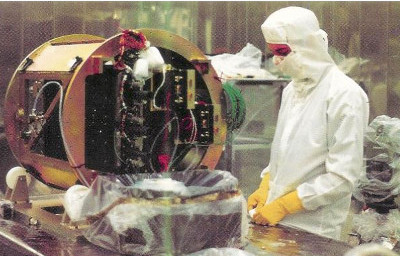
The UVCS spectrometer during the functional tests at Alenia Spazio, Turin
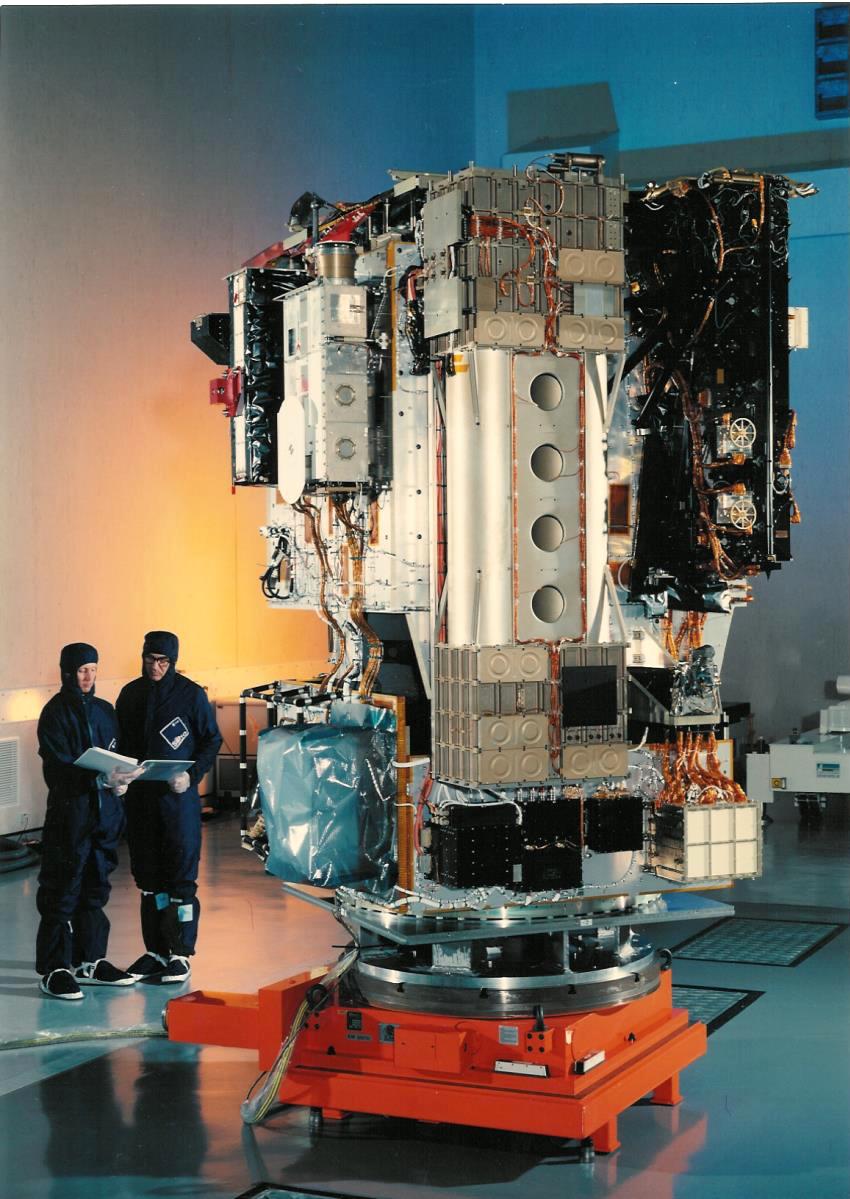
UVCS (instrument with black cover at the right) integrated in the scientific payload module of SOHO at the Matra-Marconi (Toulouse)
UVCS, a joint collaboration of the Italian solar space physics community, led by the Universities of Florence, Padua, and Turin, and the Harvard-Smithsonian Center for Astrophysics (US), was supported by NASA and the Italian Space Agency. The data obtained with UVCS led to the discovery of the regions were the wind is accelerated and of the energy deposition processes responsible for the two regimes of wind acceleration, which give origin to the slow (400 km/s) and fast (800 km/s) wind streams sweeping the heliosphere.
Metis has been designed to privilege coronal imaging in visible light and ultraviolet, whilst UVCS was primarily dedicated to UV spectroscopy. The simultaneous detection of the whole corona in polarized visible light and in the H I Lyman-α line, achievable with Metis, allows the use of the same Doppler-dimming techniques applied for the first time with UVCS to measure the global expansion of the solar corona at high spatial and temporal resolution.
Space coronagraphy
Four decades of space coronagraphy prior to Metis have allowed fundamental advances in the physics of the solar corona.
Skylab white light coronagraph (High Altitude Observatory – HAO, US) provided the first accurate observations of Coronal Mass Ejections (CMEs), within 1.5 and 6.0 R☉ (solar radii) from Sun center (1973-1974).
Search on the properties of coronal mass ejections continued with the white light coronagraph (Naval Research Laboratory – NRL, US) of the P78-1 mission, launched in 1979, and the Solar Maximum Mission coronagraph (1.6–6.0 R☉) developed by HAO, launched in 1980.
A major breakthrough in coronagraphy occurred with the launch of the SOHO powerful set of coronagraphs in 1995.
The set of LASCO coronagraphs (NRL) aboard SOHO provided continuous coronal imaging in a range from 2 to 30 R☉ and uninterrupted monitoring since 1996, by observing the corona from the Lagrangian point L1. Major contributions were given in the understanding of CME propagation and evolution beyond 2 R☉. The high sensitivity and the continuity of the observations made it possible to catch systematically the faint halo coronal mass ejections. These are the ones that are directed toward Earth and have the highest probability of being geo-effective, when impacting on our magnetosphere. Furthermore the LASCO coronagraphs contributed to the slow wind physics, studied through the motion of tracers.
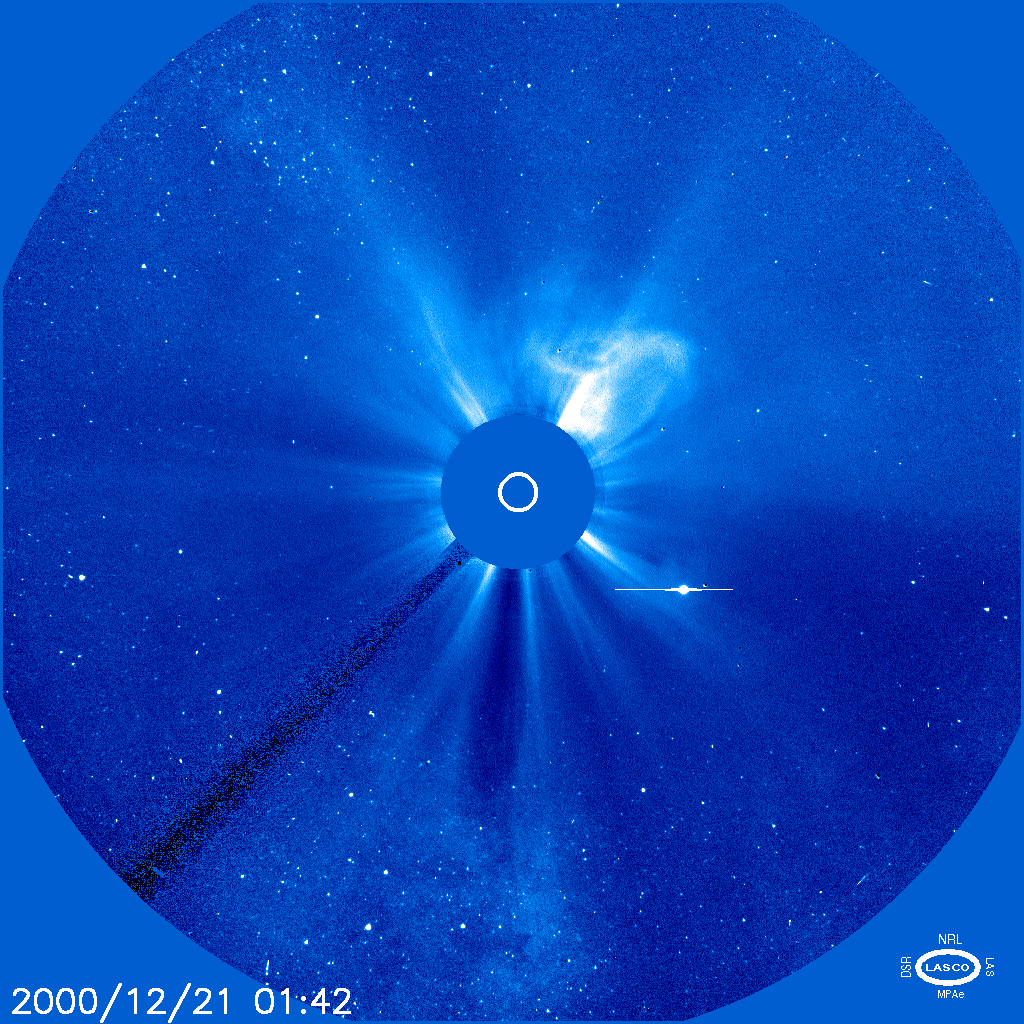
High latitude coronal mass ejection observed with LASCO C3 on SOHO, within ~ 3 and 30 R☉
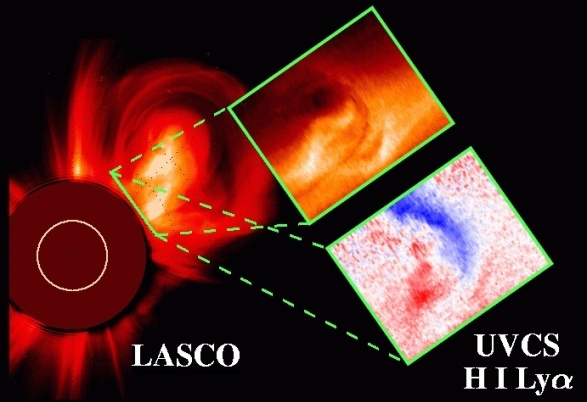
UVCS Dopplergram (red and blue plot) highlighting helical motions in a coronal mass ejection observed with LASCO C2
The Ultraviolet Coronagraph Spectrometer (UVCS) on SOHO, Metis precursor, performed the first UV spectroscopy of the outer corona, thus measuring directly coronal expansion with the Doppler dimming diagnostic techniques. UVCS discovered that ions and protons are heated at different levels in the solar wind acceleration zones of the corona and that they are expanding outwards at different speeds. UVCS also found strong anisotropies in the velocity distribution of the O VI ions across the magnetic field, related to the energy deposition process, and significant anomalies in the abundance of elements in the outer corona. CME spectroscopy casted light on shock propagation and magnetic reconnection in the outer corona, and on temperature and velocity patterns of the mass ejections.
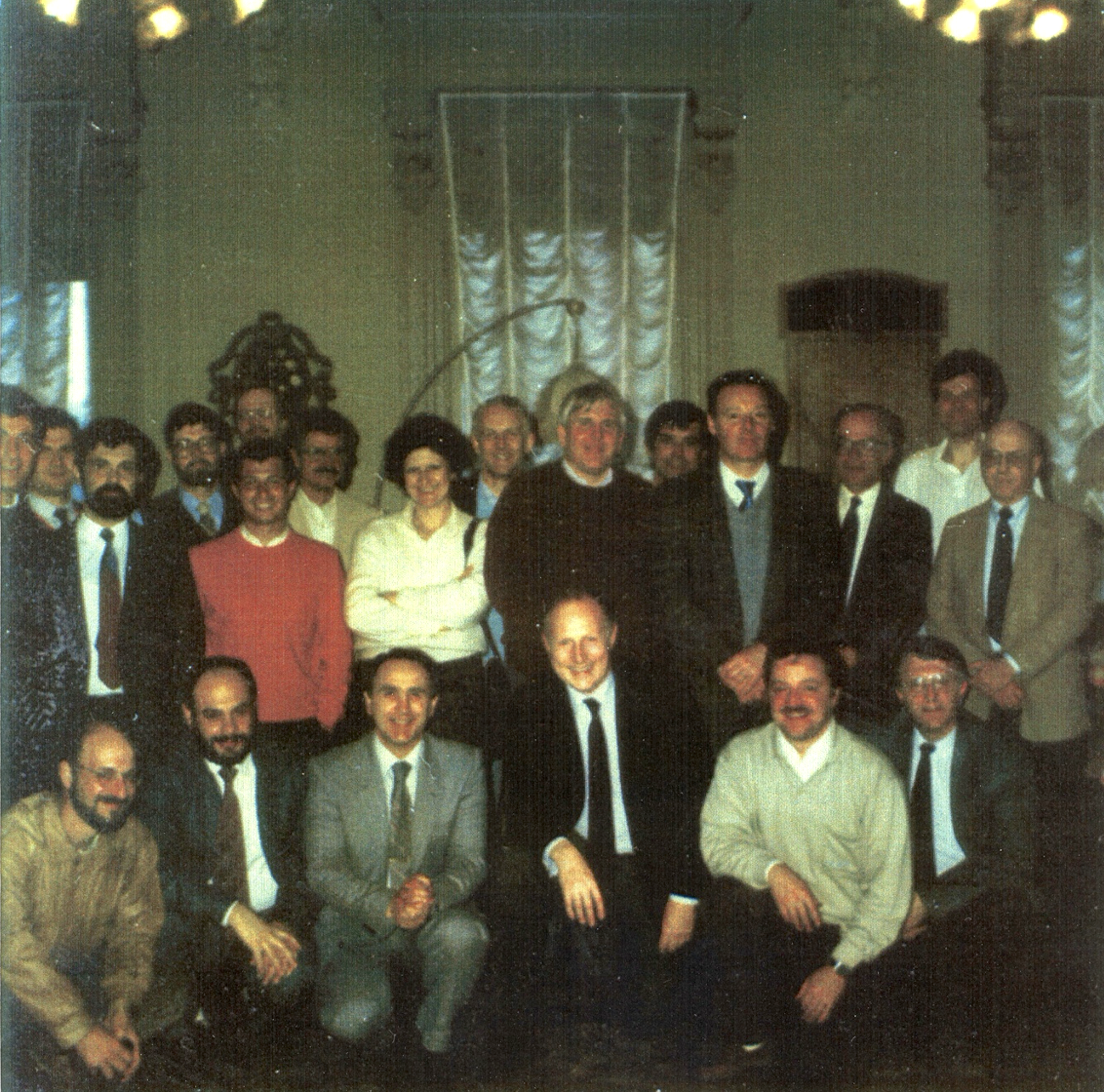
The first team meeting of UVCS/SOHO after payload selection was held in Turin on April 12, 1988. Standing scientists : Daniele Spadaro, Joseph V. Hollweg, Fabio Reale, Ester Antonucci, George L. Withbroe, John L. Kohl, Marco Malvezzi, Giancarlo Noci, Roger Kopp, Heinz Weiser. Scientists in the lower row: Alfred Buergi, G. Tozzi, M. C.E.Huber, Stefano Livi, Joseph Lemaire
A further step forward was achieved by the SECCHI coronagraphs of the STEREO mission, launched in 2006. STEREO consists of two spacecraft viewing the corona from different angles in order to observe the 3D structure of coronal mass ejections. They provide imaging and stereoscopy in polarized visible light from 1.5 R☉ in the corona to the inner heliosphere.

The two STEREO spacecraft viewing the corona from different perspectives
History of space coronagraphy
| 1930 | B. Lyot invents the inner occulted coronagraph to be used in high altitude sites. |
|---|---|
| 1948 | J. Evans invents the externally occulted solar aureola photometer. |
| 1960 | G. Newkirk and I. Eddy perform the first stratospheric balloon experiment at 25 km over sea level with a single disc externally occulted solar photometer. The coronal image was overwhelmed by the stray light. |
| 1963 | Thanks to a successful rocket flight, the Naval Research Laboratory (NRL) group led by R. Tousey obtains the first non‑eclipse image of the outer corona with a small NRL photographic coronagraph using an external occulting disc with a serrated edge. |
| 1964 | Successful balloon experiment “Coronascope II”, by the High Altitude Observatory (HAO) group (main investigators D. Bohlin and G. Newkirk) and first image of the middle corona using a 3‑disc occulting system. |
| 1965 | First attempt to fly on the satellite OSO‑2 a NRL coronagraph with a compact 3‑disc occulting system. |
| 1967 | Successful balloon experiments for recording the IR dust corona (R.M. MacQueen), using a triple straight edge occulting system and scanning IR photometer. |
| 1967‑1968 | Successful balloon experiments by the French group led by A. Dollfus for photographing the middle corona using near IR film and an external occulting disc with a serrated edge. |
| 1963‑1972 | Successful rocket flights by the NRL group of a flight instrument consisting of two coronagraphs mounted side by side to overcome the shadow effect produced by the pylon. |
| 1971‑1974 | First day‑to‑day coronal recording obtained with the NRL satellite‑borne‑coronagraph equipped with a SEC Vidicon on OSO‑7; first observation of a large flare‑induced coronal mass ejection. |
| We want to remember here Dave Roberts, one of the technicians that participated in the mission and that contributed to all the NRL solar mission ever since, down to the recent HERSCHEL/SCORE launch that is the Metis prototype (see below). He always claimed to have been the first to observe a CME and to have thought at first to a detector damage. He passed away in 2014. | |
| 1973‑1974 | Successful Skylab missions with the HAO white light flight coronagraph on the Skylab/ATM (Apollo Telescope Mount). More than 35000 high quality calibrated photographic pictures have been returned. |
| 1976 | First successful flight of a rocket‑borne Soviet coronagraph by a group of the Kiev University. |
| 1976 | Design of a new class of light externally occulted coronagraph in response to the call for proposals of experiments to be flown with the International Solar Polar out‑of‑ecliptic (OOE) Mission (ISPM). |
| 1979‑1985 | Long series of coronal observations performed with a NRL coronagraph mounted on the P‑78‑1 polar orbit defense satellite. Sun‑grazing comets discovered. |
| 1980 | Start of observations with a new generation coronagraph aboard the SMM (Solar Maximum Mission) spacecraft. In 1984, the coronagraph is successfully revived, thanks to a repair mission, and kept operating until 1989. |
| 1993 | First observations of the UV corona with the Spartan‑201 mission. The mission was including a white‑light coronagraph that was the first ever to implement a CCD as a detector and a prototype of the SOHO/UVCS (see below). |
| 1995 | Launch of the SOHO (Solar and Heliospheric Observatory) mission. It is an observatory that orbits around the Lagrangian point L1, thus continuously observing the Sun, carrying a suite of 3 visible light coronagraphs (LASCO/C1, C2 and C3) and the Ultraviolet Coronagraph Spectrometer (UVCS). LASCO C2 and C3 are still operative. |
| 2006 | Launch of the STEREO (Solar TErrestrial RElations Observatory) mission, a suite of two nearly identical spacecrafts, one ahead of Earth in its orbit, the other trailing behind. It provided the first‑ever stereoscopic measurements of the Sun. Two visible light coronagraphs (Cor‑1 and Cor‑2) and a heliospheric imager (HI) are part of the scientific payload of each spacecraft. |
| 2009 | HERSCHEL (HElium Resonant Scattering in the Corona and HELiosphere) successfully launched. It was a sounding rocket equipped with a coronagraph dedicated to the imaging of the corona in the HeII 30.4 nm line (HeCor) and a prototype of the Solar Orbiter Metis coronagraph (SCORE, Sounding CORonagraph Experiment) able to perform multiband imaging of the outer corona (VL, H I Lyman-α at 121.6 nm and He II at 30.4 nm). The mission provided the first‑ever global map of the solar corona in the He II line. |
We wish to acknowledge S. Koutchmy who has reported the history of coronagraphy in S. Koutchmy, Space Science Reviews 47, 95-143 (1988).